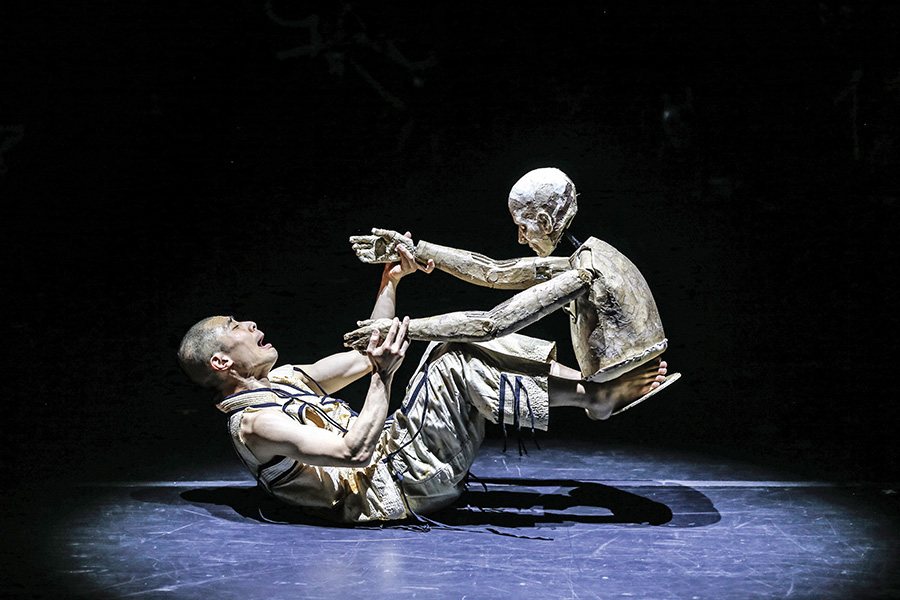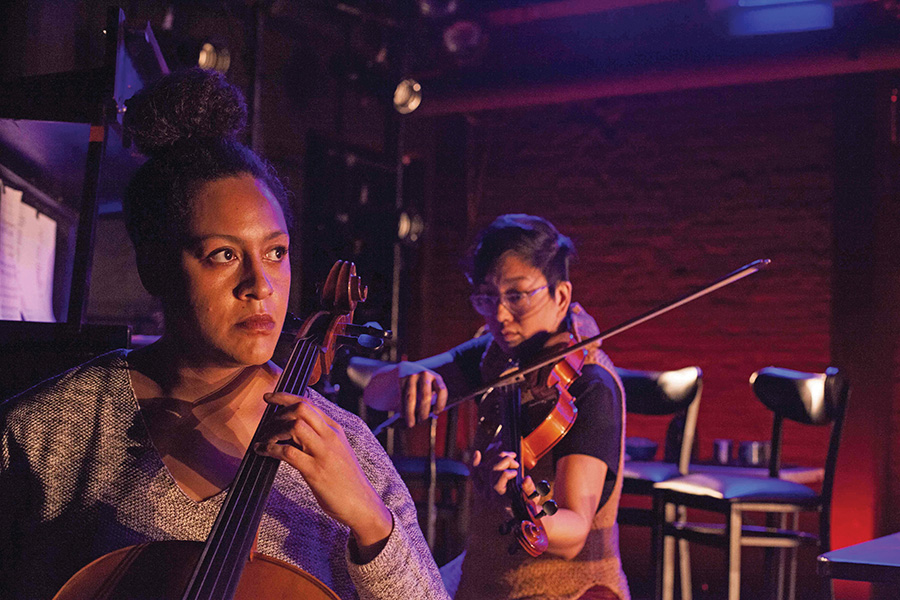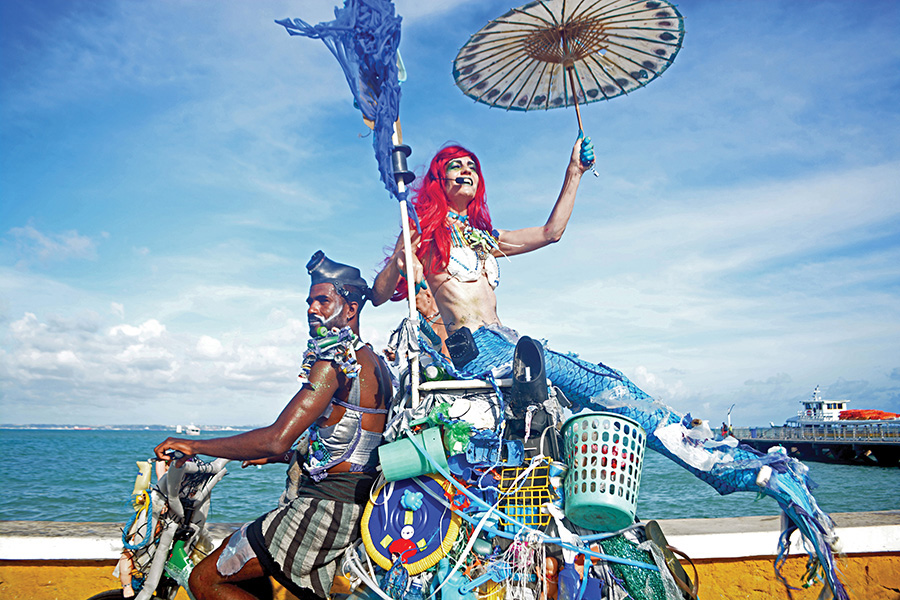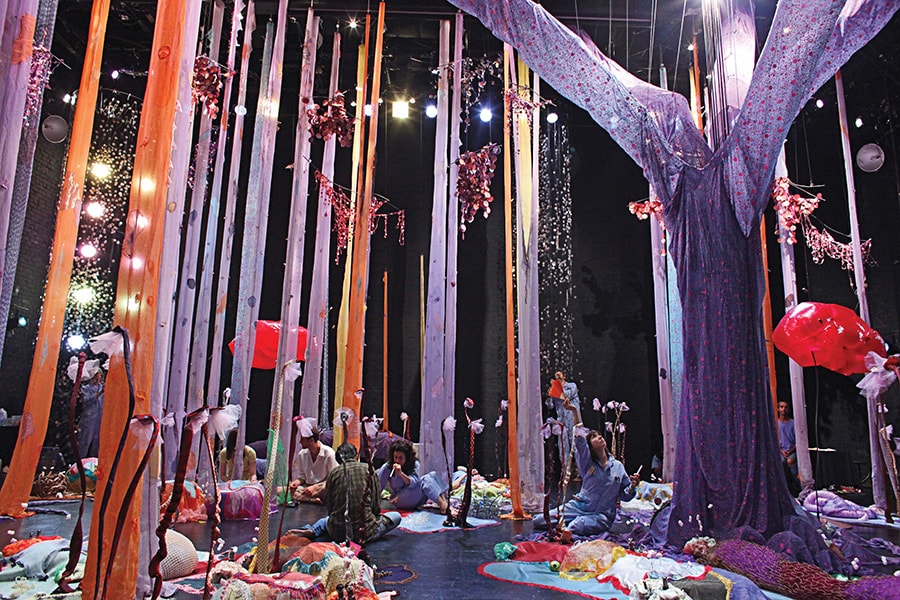This story is part of a special issue on theatre and climate change; the whole package is here.
“This is all wrong. I shouldn’t be up here. I should be back in school on the other side of the ocean…How dare you!” said Swedish teen activist Greta Thunberg to a roomful of world leaders in dark suits at the UN Climate Action Summit in New York City last September.
In a theatre venue, Thunberg’s performance would have been worthy of a standing ovation. Her speech, a superbly crafted monologue aiming to shame politicians for their inaction on climate change, made beautiful use of the refrain “how dare you,” lest we forget that the climate crisis cannot be left for the next generation to solve. And stakes? Forget your regular, run-of-the-mill life-and-death stakes. Thunberg was talking about nothing less than the death of our entire species. She went on to point out that the science is unequivocal, and concluded, “The eyes of all future generations are upon you. And if you choose to fail us, I say: We will never forgive you…The world is waking up. And change is coming, whether you like it or not.” Among other things, it was a brilliant piece of theatre.
Across the ocean in Cologne, Germany, three students from the Academy of Design staged another brilliant performance as part of a class project this past July. In a busy plaza surrounded by retail stores, including an Apple Store, they stood under gallows with nooses around their necks, perched on blocks of ice that were melting under their feet. This feat of theatricality, which encapsulates the stakes of our climate crisis in one visceral image while hinting at the role of the colonial mindset in getting us there, has been haunting me since I saw a video of it on the internet.
These are the moments I look for—the moments we all look for—when we go to the theatre: unexpected, earth-shattering, awe-inspiring moments of truth presented in all their nakedness. Moments when we can catch a glimpse of beauty among the rubble, grace in the midst of greed and corruption, hope in unlikely places. And in these two instances, it was hard not to notice that theatre broke free of its institutional habitat, walked out onto the street and into civic buildings, and in the process reasserted its rightful place in our society.
Over the last decade, “climate change theatre” has been infiltrating our art form—and our lives. I’m putting the term in quotes intentionally, because despite being a useful shorthand, it’s also problematic similiar to the way terms like “women’s theatre” or “Black theatre” are problematic. It assumes that this is a niche topic, irrelevant to the uninitiated. It also conjures up visions of propaganda theatre, or the dreaded “issue play,” in which the audience is being preached at and admonished to give up their evil ways. Work that truly engages with climate change should be, and often is, anything but a niche activity or a sermon. And what makes it most exciting is that there’s no precedent for it.
Climate change—by which I mean the significant changes to our global climate caused by the dangerous accumulation of carbon dioxide in the atmosphere—is not at bottom a difficult problem to solve. It’s a simple mathematical equation: fewer emissions = less disruption of the climate. We even have the technological know-how. What has stumped us for the last 30 years is how to change the worldview that created climate change in the first place, and is accelerating it heedlessly. As Jeremy Lent writes in The Patterning Instinct: A Cultural History of Humanity’s Search for Meaning:
Each of us conducts our lives according to a set of assumptions about how things work: how our society functions, its relationship with the natural world, what’s valuable, what’s possible. This is our worldview, which often remains unquestioned and unstated but is deeply felt and underlies many of the choices we make in our lives. We form our worldview implicitly as we grow up, from our family, friends, and culture, and, once it’s set, we’re barely aware of it unless we’re presented with a different worldview for comparison. The unconscious origin of our worldview makes it quite inflexible.
In recent decades, cognitive scientists have shown that our worldview is based on root metaphors, also called myths. The Western world’s dominant root metaphor since at least the advent of the Scientific Revolution in Europe in the 16th century, a metaphor that has now enveloped the entire globe, has been Conquest of Nature. Since the Old Testament ostensibly gave humankind dominion over animals, this was interpreted by the early modern scientific community as license to claim dominion over everything: land, resources, even other human beings. Stories that supported this paradigm quickly followed, shaping our collective and individual lives into an endless series of conquests ranging from colonialism to capitalism. Even our dramaturgy talks of “conquering” obstacles.
But we are now at a crossroads, and unless we take action to change, our current root metaphor will, quite literally, kill us. There is no doubt that Conquest of Nature has played itself out. As Thunberg says, change is coming, whether we like it or not.
So while making theatre about climate change may indeed mean stories about oil extraction and deforestation, sea level rise and extreme weather events, it really means creating a new root metaphor for our lives—a new worldview. We artists and creators are being called upon to imagine the story that could shape the next millennia. Ours should be a golden age of theatre, an explosion of new voices and stories, of bold forms and theatricality, of explorations of deep time and interspecies relationships, all buoyed by a renewed passion for breaking all the old rules.
Our cousins in England seem to have embraced this challenge wholeheartedly, turning out a steady stream of climate-themed plays over the last decade. Among the most well-known are Steve Waters’s The Contingency Plan (2009), Nick Payne’s If There Is I Haven’t Found It Yet (2009), Zoë Svendsen’s 3rd Ring Out: Rehearsing the Future (2010), Duncan MacMillan’s Lungs (2011), Caryl Churchill’s Escaped Alone (2016), and Lucy Kirkwood’s The Children (2016). The U.K. has also developed innovative programming, including climate-focused residencies (Climate Change in Residence: Future Scenarios at the University of Sheffield, and International Climate Crisis Plays at the Royal Court Theatre) and climate change leadership trainings (Julie’s Bicycle’s Creative Climate Leadership).
In the U.S., we have been much more reluctant to tackle the subject, particularly on our larger stages. In fact, when Marshall Botvinick, in a HowlRound article last fall, looked at U.S. world premieres in the 2019-20 season at 75 member theatres of the League of Resident Theatres and the 32 National New Play Network core member theatres, he found that exactly zero percent of plays had climate change or the environment as a thematic focus. But despite this depressing statistic, exciting new works by American theatremakers continue to emerge. Here’s a small sample of some of my favorites.
PearlDamour
A few years ago, American Repertory Theater, with support from the Harvard University Center for the Environment, commissioned a group of playwrights to write plays addressing the climate crisis. One of these commissions went to the duo PearlDamour, comprising Katie Pearl and Lisa D’Amour, who wrote the highly theatrical play Ocean Filibuster. Drawing from myth, stand-up, and science, and featuring projections, a six-person choir, and songs by Sxip Shirey, Ocean Filibuster invites audiences to a futuristic senate chamber showdown where a newly introduced bill proposes
that the world’s oceans, collectively known as
The ocean
Be put to death
But when the floor is opened for debate, the Ocean arrives to speak in its own defense—and doesn’t stop. Asked about the premise of the play, Pearl said, “We thought, well, what if the Ocean finally got fed up with taking all of our crap, and started talking and didn’t stop until we actually shut up and listened?” Ocean Filibuster recalibrates the human experience by reminding us of the comparatively small scale and depth of our own existence. In a tour-de-force performance, Jenn Kidwell played the two characters, Mr. Majority and the Ocean, for a work-in-progress presentation at Abrons Arts Center in New York in December 2018. The play is slated to premiere at ART this coming fall.

Phantom Limb
Equally theatrical and visually stunning, and almost entirely devoid of words, Phantom Limb Company’s trilogy of works—69°S (2011), Memory Rings (2016), and Falling Out (2018)—use projection, puppetry, and dance to grapple with humans’ relationship to nature and climate change. The three shows focus on ice, wood, and water, respectively, and are inspired in turn by Sir Ernest Shackleton’s 1914 Antarctic expedition; the impact of 4,784 years of a living being, and the poetry of age shown through dendrochronology (the science of dating events using the patterns of annual growth rings in trees); and the earthquake, tsunami, and subsequent nuclear meltdown that ravaged the region of Fukushima, Japan in 2011.
In a 2017 interview published on the website Artists & Climate Change, artist, director, set designer, and Phantom Limb co-founder Jessica Grindstaff explained that “direct, instructive, didactic information about climate seems to slide right off of most people’s back. [But] the puppets somehow manage to creep into our most vulnerable parts and resonate.” Resonate they most certainly do. From life-size humans to gigantic beings to whimsical woodland creatures, Phantom Limb’s puppets create poetic worlds that invite empathy, compassion, and a deep sense of interconnectedness. They encourage audiences to look beyond the mundane and reconnect with everything that is mysterious and magic, both inside and around us.
One striking image from the 2018 Brooklyn Academy of Music production of Falling Out had me all choked up and on the edge of my seat. A dancer walked in slow motion, in pitch black except for a bright spot of light on his head and shoulders. With each excruciatingly slow step, he lowered his body ever so slightly while the light remained at the same level. Eventually, he disappeared entirely, creating the illusion that he had drowned into a sea of darkness. Grief is an unavoidable part of renewal.

Superhero Clubhouse
Another duo, Lani Fu and Jeremy Pickard, co-direct the New York City-based Superhero Clubhouse, and have been working on a time-warping musical play titled Mammelephant. First presented as a work-in progress at the New Ohio and HERE Arts Center in February 2019, Mammelephant explores otherness and displacement in the era of climate change through the eyes of the world’s first mammoth-elephant hybrid and generations of female ancestors.
Mammelephant is inspired by Pleistocene Park, a real-life experiment in Russia that aims to transform the warming Siberian tundra into the cool grasslands ecosystem of the Ice Age; part of the scheme involves a plan to reintroduce the mammoth by splicing DNA from a preserved mammoth carcass into live Asian elephants. Mammelephant’s structure adapts the form of Olonkho, a narrative tradition of the native Yakuts people of the Sakha Republic. Olonkho is an epic poem that can range from 10 verses to 15,000, rendered by a solo performer who switches among singing, storytelling, improvisation, and music, taking on the voices of characters throughout.
The play follows the imagined life of the first hybrid mammelephant as she tries to create a future for herself in uncharted territory. Accompanying this myth are three female ancestors, played by a trio of musicians, who represent mammoth, elephant, and human aspects of the mammelephant’s lineage. The play will be developed through 2019-21 as part of Theatre Row’s inaugural Kitchen Sink residency, and should premiere on Theatre Row in 2021.

Siren Arts
At the other end of the theatrical spectrum is Florida-based performer Elizabeth Doud of Siren Arts, who creates wild shows meant to be performed outdoors, and who is gearing up for Mermaid Truth or Consequences: A Biodiversity Game Show, to be performed around Miami Dade County starting this May. The first stop, a place called Plant the Future, is an old gas station along the Little River in Miami’s Little Haiti.
A live, interactive game show hosted by two radical mermaids, Mermaid Truth or Consequences will spill out of a parked trailer to strike up conversations with environmental experts about biodiversity and mass extinction. These pop-up performances will occur along beaches, in parking lots, on the banks of polluted rivers, and at farmers markets, using a recipe that is one part game show, one part science jam, and one part group mermaid catharsis via magical dances and irreverent siren songs. The show will be in three languages: English, Spanish, and Haitian Creole. Like the Cologne performance I mentioned above, this is a beautiful example of taking theatre to the people, stripping it of all pretensions to make a genuine connection with communities and engage them in conversation about an issue that affects us all.
When a character in Mammelephant asks, “What is the sound of two-and-a-half million years melting?”, or the Ocean in Ocean Filibuster says “in human terms I am about three billion years old,” or we get to see the representation of a four-millennia-year-old tree in Memory Rings, we may begin to appreciate how the story we’ve been telling ourselves—the story in which our young, 200,000-year-old human species has unchecked power over the much, much older planet we occupy—is hopelessly naïve. The bold and innovative works of theatre presented here, and others like them, offer glimpses of a much broader world that chip away at our old creation myth and force us to envision a different future. They expose the cracks we’re so good at patching (but not fixing), and help us see the possibilities in front of us.
In an article titled “We Need an Ecological Civilization Before It’s Too Late,” published on his blog Patterns of Meaning, Jeremy Lent shares his own vision of what our new root metaphor could look like:
An ecological civilization would be based on the core principles that sustain living systems coexisting stably in natural ecologies. Insights into how ecologies self-organize offer a model for how we could organize human society in ways that could permit sustainable abundance. Organisms prosper when they develop multiple symbiotic relationships, wherein each party to a relationship both takes and gives reciprocally.
If there were ever a need for theatre artists, it is now. If there were ever a time for creativity and imagination, it’s in this very moment of massive global transition. The real value of climate change theatre is not in helping us figure out whether to recycle more or eat less meat. The real value lies in its potential to dig deep and help reshape the very foundation of who we are.
Chantal Bilodeau is a playwright whose work focuses on the intersection of science, policy, art, and climate change. She is also the artistic director of the Arctic Cycle.
Creative credits for photos: How to Build a Forest. Created by PearlDamour (Lisa D’Amour and Katie Pearl) and Shawn Hall; sound: Brendan Connelly and Christopher DeLaurenti; lighting: Miranda Hardy and Peter Ksander.
Falling Out. Direction and sets: Jessica Grindstaff; original music and puppet design: Erik Sanko; Butoh master: Dai Matsuoka; video design: Keith Skretch; costumes: Henrik Vibskov; lighting: Brian H Scott; sound: Darron L West.
Mammelephant. Text: Lanxing Fu; direction: Jeremy Pickard; music: Treya Lam and Serena Ebony Miller; sound and additional text: Eva von Schweinitz; choreography: KatieRose McLaughlin; lighting: Alejandro Fajardo.
A Fábrica de Lágrimas de Sereia/The Mermaid Tear Factory. Created by Elizabeth Doud; direction and scenography: Giovanni Luquini; costumes: Estela Vrancovich.
CORRECTION: An earlier version of the creative credits for this story misspelled designer Miranda Hardy’s last name as Hardsy.


